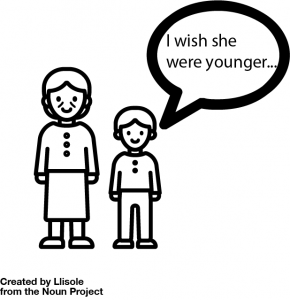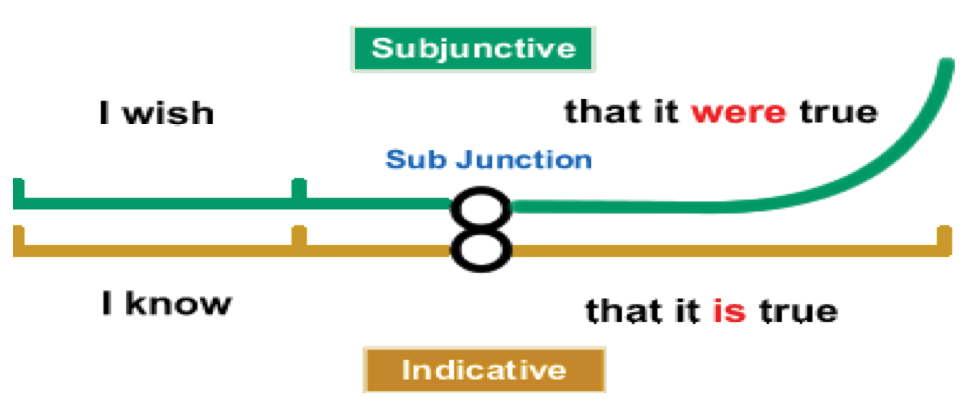Unidad 2: De compras y la ropa
10. Aprendiendo a expresar deseos y necesidades de otra persona: Introducción al subjuntivo
Recordemos los modos: Indicativo, subjuntivo e imperativo
A verb is a word that typically expresses action, state or relation; it is marked for tense, mood and voice. We already studied mood and tense, but let’s review these important concepts.
El modoàmood: a category or set of categories of a verb that indicates the attitude of the speaker toward what is being said, as in expressing a fact, a question, a possibility, a wish, or a command.
The indicative mood is used in statements à He is there.
The imperative mood in commands à Be there!
The subjunctive mood in certain kinds of wishes à I wish he were here!
The mood and the tenses are inseparably linked; some moods have multiple tenses while other moods have only one tense. In English as in Spanish, the three moods are used in the same way.
The indicative mood is used to indicate facts. This is the most common mood, and most of the verb forms that we use in everyday conversation belong to the indicative mood. We have been studying the indicative mood in the present tense with all our regular and irregular verbs.

El tiempoàtense: of a verb indicates when the action of the verb takes place: at the present time, in the past or in the future:
I study à present à yo estudio
I studied à past
I will study à future
Just putting the verb in the different tenses and without giving any additional information such: I am studying now, I studied yesterday or I will study tomorrow, we are able to know when the action takes place.
Now we will study the subjunctive mood which is used to express the feelings or opinions so that another person performs an action of the verb. In English, this mood is not divided into tenses, but in Spanish, this mood is also divided in tenses. As you may recall, it is the subjunctive mood that indicates uncertainty about the action.
- Subjunctive: Unclear like a clouded sky
- Usually subjunctive: Partly cloudy sky
- Indicative: Sunny
Here is a reminder of the moods and the tenses in Spanish.
Remember: mood and tenses are linked; each mood has its specific tenses. To conjugate a verb first you need to decide the mood and then the tense.

Indicative
Is defined as an action that is actual, factual and certain.
- Several tenses that you will learn throughout your courses are:
- Present
- Preterit
- Imperfect
- Present perfect
- Past perfect
- Future
- Future perfect
- Conditional
 Imperative
Imperative
Is based on commands and giving orders.
- The imperative mood only has one tense or time—present—which makes sense when you think about if you give someone a command, you want them to do the action now (in the present.)

Subjunctive
Is defined as something that is uncertain, nonexistent, doubtful, hypothetical, based on the emotions, wishes, wants, hopes, needs of one subject toward the actions of another subject.
- Several tenses that you will learn throughout your courses are:
- Present
- Imperfect
- Present perfect
- Past perfect (pluperfect)
The indicative, the subjunctive and the imperative are not tenses, they are moods!
The section above defines the Subjunctive mood as something that is uncertain, nonexistent, doubtful, hypothetical, based on the emotions, wishes, wants, hopes and needs of one subject toward the actions of another subject. Keeping this in mind…




Observa the next powerpoint notes 2.2.6 on the formation of sentences and questions in the subjunctive and take notes to fill in certain sections of the pages below.
What you will see GENERALLY when forming sentences in the SUBJUNCTIVE:
- 2 different subjects.
- A pattern similar to one of the formulas below (again this will serve for the majority of sentences with the subjunctive but other words may be included in a sentence.)
Subject 1 + Verb 1 + (Extra Info.) + que + Subject 2 * Verb 2 (Extra info.)
- Subject 1 A proper name (Elisa), a pronoun (ella) or an understood element such as “it” (It is necessary/es necesario…)
- Verb 1 is in the present indicative (the present tense you are used to using). There are certain verbs in this clause that invoke the subjunctive. Not all verbs require that you use subjunctive in the 2nd half of the sentence.
- Extra details in either clause are optional such as a time frame or adverbs, etc.
- Que has to be present in the sentence (but may be replaced with words as Ojalá, tal vez, quizás that we will study later.) In English, we do not always use “that” as part of a subjunctive sentence.
- *Subject 2 is different than subject 1.
- Verb 2, this verb is in the present subjunctive.
Subject 1 + Verb 1 + (Extra Info) + Subject 2 + que + Verb 2 + (Extra info)
Think about the following English examples and label the parts per the formulas above.
- I want the Buffalo Bills to win a Superbowl. (Do I know if this will happen?)
- She needs a seat that is close to Hugh Jackman at the fashion show.
- Carolina Herrera advises me not to wear yellow.
- Oscar de la Renta and Carolina Herrera suggest they wear shoes not sneakers with their suits.
- We hope you can make it to graduation.

What about these sentences? Are they subjunctive or indicative moods? Explain why:
- I have a ticket to the theatre. ___________________________
- I need a seat. __________________________
- I paid for the ticket. ______________________________
- The director wants the actor to change clothes. ________________________
- My mom wants me to wear a different outfit to dinner. ___________________
- We’re happy that you are going to our graduation party. ________________
You are starting to see the differences in the moods! Now we need to work on forming the sentences in Spanish.
Verb 1: The verb for verb 1 has to be part of an “elite” group that indicate emotions or opinions about the actions of someone else.. Just because I want or will something to happen, does not mean that it will happen. There are many expressions and triggers for subjunctive that you will learn in subsequent courses but for now we will learn how to express what we want or need another subject to do and opinions on what others do.
When forming sentences in the present subjunctive, Verb 1 may be in the following tenses for the indicative mood: present, present progressive, future and, sometimes the imperative mood will be used but as you know the imperative has just one tense which is the _________________________.
| Verb 1 | Verbs / expressions in Spanish that apply |
|---|---|
| Wants/wishes | |
| Opinions | |
| Need |
You will see with practice how naturally you will be able to communicate with this mood and tense the following thoughts.
I want you to come to my party. It is important that you see your teacher for help. They need me to be at work by 8AM. Notice the first verb is in the present tense and is a reality to the speaker, hence the indicative form is used for the first verb.
Did you also notice there is a second subject highlighted in green? This is where the subjunctive mood in the present tense is used. The first subject has no control over the second subject’s actions. The second subject’s actions are not completed, have not happened yet, are outside of reality or non-existent which is the whole meaning of the subjunctive mood.
¡Conjuguemos en el modo subjuntivo en el tiempo presente!
We already studied how to conjugate the regular verbs in the indicative mood in the present tense. We take off the end of the infinitive and we use the next endings for each person for the indicative mood in the present tense:
AR–o, as, a, amos, áis, an
ER–o, es, e, emos, éis, en
IR– o, es, e, imos, ís, en
To conjugate a verb in the subjunctive mood in the present tense is very simple:
First step: Use the form of the verb in the present tense indicative in the first person singular: “yo.”
Infinitive: hablar Present tense indicative : yo hablo.
Infinitive: beber Present tense indicative : yo bebo.
Infinitive: escribir Present tense indicative : yo escribo.
Second step: Drop the “o”
Present tense indicative : habl
Present tense indicative : beb
Present tense indicative : escrib
Third step: Add the opposite endings à
AR – e, es, e, emos, éis, en à hable, hables, hable, hablemos, habléis, hablen.
ER – a, as, a, amos, áis, an à beba, bebas, beba, bebamos, bebáis, beban.
IR – a, as, a, amos, áis, an à escriba, escribas, escriba, escribamos, escribáis, escriban.
You just learned how to conjugate the verbs in the subjunctive mood in the present tense!

To add to your vocabulary, study the following verbs. Some you may recognize from our verb formation practices. For practice, write the present indicative and present subjunctive forms.
| Español | Inglés | Presente indicative “yo” | Presente subjunctive “yo” |
|---|---|---|---|
| Abrir | To open | ||
| Alquilar | To rent | ||
| Apagar | To turn off | ||
| Aprender | To learn | ||
| Asistir | To attend | ||
| Ayudar | To help | ||
| Cambiar | To change | ||
| Cancelar | To cancel | ||
| Cobrar | To charge (a bill) | ||
| Conducir | To drive | ||
| Conocer (yo) | To know/to be familiar | ||
| Cortar | To cut | ||
| Costar (o—ue) | To cost | ||
| Cuidar | To care / to take care of | ||
| Doblar | to turn | ||
| Encontrar (o—ue) | To meet/encounter | ||
| Esperar | To hope, wish | ||
| Funcionar | To function | ||
| Girar | To turn | ||
| Hacer (irreg yo) | To make | ||
| Limpiar | To clean | ||
| Mantener (irreg) | To maintain | ||
| Pagar | To pay | ||
| Pasar (pasar por) | To pass/to pass by | ||
| Pedir (e—i) | To ask for | ||
| Poder (o—ue) | To be able/can | ||
| Poner (yo—go) | To put | ||
| Prestar | To borrow/loan | ||
| Quedar | To be located | ||
| Recomendar (e-ie) | To recommend | ||
| Saber (irreg- yo) | To know a fact | ||
| Sugerir (e—ie) | To suggest | ||
| Tener éxito (irreg) | to be successful | ||
| Visitar | To visit |
In the indicative mood in the present tense we studied many irregular verbs. The subjunctive in the present tense also has irregular verbs. To help you remember the irregular verbs in the subjunctive mood in the present tense you can use DISHES:
D – dar: dé, des, dé, demos, deis, den
I – ir: vaya, vayas, vaya, vayamos, vayáis, vayan
S – saber: sepa, sepas, sepa, sepamos, sepáis, sepan
H – haber: haya, hayas, haya, hayamos, hayáis, hayan
E – estar: esté, estés, esté, estemos, estéis, estén
S – ser: sea, seas, sea, seamos, seáis, sean
Before creating sentences in the subjunctive mood, let’s analyze the indicative vs the subjunctive mood:

Indicative
- Expresses facts, actual, known information or definite events—CERTAINTY.
- This part of the sentence can stand alone. It is an independent clause.
Subjunctive
- Subjective/hypothetical/uncertain. (It reflects the speaker’s feelings, needs, or attitudes / doubts, fears, UNCERTAINTY toward another event or subject’s actions.)
- Used to express well-wishes.
- This part of the sentence does not stand by itself and thus is a dependent clause.
- Is based on trigger words that are in the INDICATIVE mood for the first half of the sentence/question.
Remember the conditions requiring the use of the subjunctive mood, we are going to start with the letter “W = Will/Wishes”. We are going to learn how to express desire of one subject toward the actions of another subject. It is crucial to keep in mind that we are talking about the desire of one subject about the action of another subject.
Sentence formation in the subjunctive and in this case, the present subjunctive may be looked at somewhat formulaically:
What you will see GENERALLY when forming statements in the SUBJUNCTIVE:
- The statement has two clauses:
- 2 subjects not = to each other (ie: 2 different subjects.)
- each subject is performing an action (ie: 2 different verbs.)
- One clause is subordinate to the other clause.
- The independent clause is in the indicative mood.
- The subordinate clause(1) is almost always in the subjunctive mood.
- The two clauses are linked by the preposition “que” forming the statement.
- A pattern similar to one of the formulas below (again this will serve for the majority of statements with the subjunctive but other words may be included.)
Aprendamos la fórmula para el subjuntivo:
Subject 1 + Verb1 + Extra Info que + Subject 2 ** Verb 2 + Extra info
Estudiemos el ejemplo:
Yo (subject 1) quiero (verb 1) sinceramente (extra info.) que mi novia (subject 2) me visite (verbo 2) pronto (extra info)
Independent clause: Indicative Mood, Present tense
Subordinate clause: Subjunctive Mood, Present tense

The trick to knowing if a sentence will include the subjunctive mood is looking for the triggers that indicate desire such as those that indicate Will/Wishes” as “querer” (to want), “desear” (to desire/want), or “esperar” (to wish). Don’t forget it is the desire, emotion or hope of one subject about the action of another subject that dictates if a sentence will use the subjunctive.
Comparemos el modo indicativo vs el modo subjuntivo en el tiempo presente expresando deseo:
Notice the subjunctive is a very different concept in English; we are not translating the sentences to avoid confusion. It is important that you understand the concept in Spanish.
- Indicative: Sunny
- Subjunctive: Unclear like a clouded sky
- Usually subjunctive: Partly cloudy sky
| Modo indicativo tiempo presente | Modo indicativo tiempo presente |
|---|---|
| Yo quiero comer. | Yo quiero que mi novia coma. |
| Only one sentence. | Two clauses linked with the preposition “que”. |
| The subject has a want but the want is directed toward himself. | The subject has a want, wish or desire that someone else do something. |
| Ella quiere tomar un café. | Ella quiere que su novio le compre un café. |
| El doctor quiere estudiar español. | El doctor quiere que su hija estudie español. |
| Ellos esperan una bufanda. | Ellos esperan que su mamá les haga una bufanda. |
| Queremos llevar un traje a la boda. | Queremos que los novios lleven la ropa formal a la boda. |
You are able to express desire and hope for a third person using the subjunctive mood. Need is another emotion that can trigger the subjunctive. You know that “necesitar = to need”. Let’s examine the following examples:
| Modo indicativo tiempo presente | Modo indicativo tiempo presente |
|---|---|
| Yo necesito estudiar el subjuntivo. | Yo necesito que mi novia estudie el subjuntivo. |
| Only one sentence. | Two clauses linked with the preposition “que”. |
| The subject needs something for himself. | The subject has a needy for the third person to do something. |
| Ella necesita un suéter. | La madre necesita que su hijo se ponga un suéter. |
| Ellos necesitan una gorra y una camiseta para jugar con el equipo. | Ellos necesitan que sus padres compren la gorra y la camiseta para jugar con el equipo. |
| Nosotros no necesitamos un regalo. | Nosotros necesitamos que vosotros vengáis a la boda y a la recepción. |
| El doctor necesita los resultados. | El doctor necesita que el laboratorio tenga los resultados. |
¡Tus profesores quieren que tú sepas la diferencia entre el modo indicativo y el modo subjuntivo!
¡Necesitan que tú puedas usar el modo subjuntivo!

TAREA: You have just been accepted to university! Write your thoughts based on the following prompts: Please complete the following list. Remember to incorporate the subjunctive when applicable:
- 5 statements about what you want to do when you are there.
- 5 statements about what you want in a dorm (subjunctive).
- 5 things that you need to do, to succeed in your studies.
- 5 statements about the characteristics you want in a roommate or things you want him/her to bring. (subjunctive).
You should have 20 or more statements written. Make sure to double space so your professor can offer suggestions and edits as necessary.






